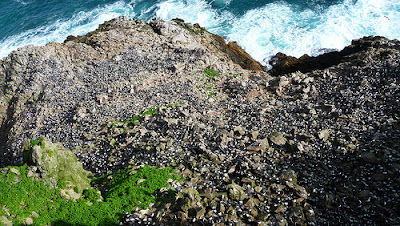| Blowing so hard even the gulls can't stand up! |
According to my oceanography textbook, the spring transition is when weather and ocean conditions shift from predominantly winter conditions to spring/summer conditions and marks the beginning of the upwelling season. Winter is typically dominated by southerly winds, frequent storms and rain. Whereas spring and summer are typically dominated by strong north/northwesterly winds, clear skies, and more arid conditions. The wind often blows so hard during the spring that it is difficult to walk around. (see A Mighty Wind posting from April 2009).
 This shift is extremely important for biological productivity in the waters around the Farallones. The strong northwesterlies drive the process of upwelling that brings cold nutrient rich water to the ocean surface and, coupled with abundant sunshine, spurs on the production of phytoplankton that forms the base of the food chain.
This shift is extremely important for biological productivity in the waters around the Farallones. The strong northwesterlies drive the process of upwelling that brings cold nutrient rich water to the ocean surface and, coupled with abundant sunshine, spurs on the production of phytoplankton that forms the base of the food chain. On the Farallones, however, the spring transition is more than just a change in the winds. The whole island is transformed to make ready for the next wave of wildlife (and wildlife biologists) to inhabit these rocky shores. The elephant seals have finished their breeding season, the last pups have been weaned and the adults have departed the island in search of food to recover the fat reserves they depleted during the long winter fast. Along with them went the winter crew. After spending the last 3 ½ months diligently caring for the island and its wildlife, they have returned to mainland to write up their findings, pursue other interests and prepare for next year. The abundant rains during this past winter have produced a lush blanket of vegetation covering the entire island. The Farallon weed (Lasthenia maritima) is in full bloom and taller than we have seen in many years.
 |
| The marine terrace and hill in spring bloom |
But most importantly to those of us now on the island, the spring is when the seabirds return to the island to set up nesting and begin breeding. Over the next six months, the seabird crew will dedicate our energy to studying the population trends, survival, diet, and reproductive success of the 13 species of seabirds which call these rocky islands home. More than a quarter million seabirds breed on the Farallones each year, including approximately half the world’s population of Ashy Storm-petrels, the world’s largest breeding colony of Western Gulls, and the largest colony of Common Murres in California with approximately 250,000 birds!
 |
| Common Murre breeding colony on Shubrick Point |
So far, things are looking good. Cassin’s auklets have already begun breeding in good numbers and the other breeding species have returned to meet up with their mates, re-establish their territories and begin the process of nest building. Although we are in the midst of an El Niño, the effects seem to be minimal on the Farallones so far. We may even have a new breeding species on the island this year. A pair of Common Ravens has been present on the island for the last few months and has recently been observed gathering nest material. Raven’s haven’t bred on the Farallones since 1911! It will be interesting to see what effect these intelligent predators have on the seabird colonies.
| Common Raven carrying nesting material |
